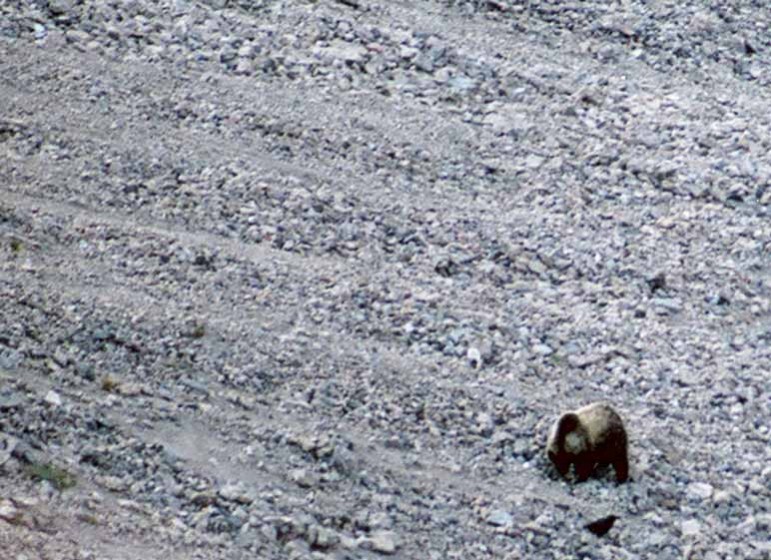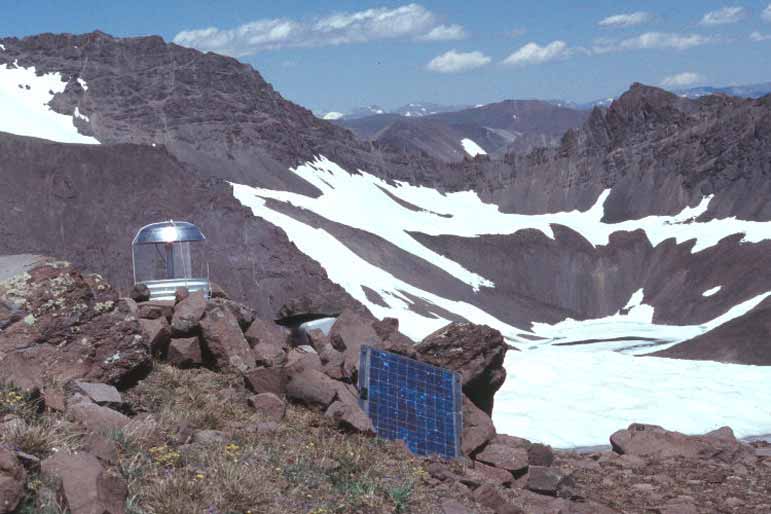
A raven waits nearby as a grizzly bear digs among rocks on a talus slope while searching for moths to eat.
As aspen leaves turn the gold of fall, grizzly bears in the greater Yellowstone area endure the final mania of their annual feeding frenzy before winter’s hibernation. The omnivorous bears compulsively pack on the pounds with berries, fish, carrion, whitebark pine seeds and a food unique to the Rocky Mountains—thousands of army cutworm moths.
Also known as miller moths, they are the adult form of an agricultural pest, the army cutworm, which migrates to mountain fields in early summer to feed on alpine flowers’ nectar. During the past 30 years, a handful of researchers have established the importance of moths as a food source for bears.
One group of scientists analyzed bear scat and revealed that a foraging grizzly could gobble 40,000 moths in a day. At that rate, the bear can consume about one-third of its yearly energy requirements in just 30 days. However, the moths’ habits—including where they mated, when they mated and how far they could migrate—have remained a mystery until recently.
“The migration of the moth is pretty unusual in North America,” said Whitney Cranshaw, a professor of entomology at Colorado State University. The army cutworm moths travel hundreds of miles from lowland fields to the mountains in late May and early June. Moths in Colorado’s mountains hail from alfalfa and wheat fields as distant as Kansas and Nebraska. Yellowstone area moths fly from a broad region spanning Idaho, Montana and Wyoming. No other moths in the continent make a similar journey, he said.
In the summer, the moths fly to slopes above 9,000 feet in elevation in search of flowers and cooler temperatures, Cranshaw said. While feeding on nectar, the moths increase their fat stores from about 13 percent to 83 percent of their body mass.
Moths that survive bear grazing mate in the mountains or during their flight back to the lower-elevation fields in early fall. There, the females lay eggs that will hatch in late fall. The larvae stick out the winter underground and emerge in the spring to feed.
“The cutworms get their name because many of them will cut plants—seedlings—and drag them into the ground where they eat them,” said Cranshaw. Outbreaks vary from year to year, depending on rainfall and the abundance of vegetation. In some years, farmers need to spray and in other years not at all. When cutworms decimate the plants in one area, they crawl to the next en masse, crossing roads and fields as an army.
Hillary Robison extensively researched army cutworm moths as part of the grizzly bear diet while a doctoral student the University of Nevada in Reno. She was driven to figure out how important the moths were and what implications they might have on grizzly bear management. “If [the moths] come from specific areas and we lose that habitat, that will affect the bears,” she said. To answer her questions, Robison spent years studying the moths in the Absaroka and Teton mountains surrounding Yellowstone.
Given the concern that some cutworms may survive spraying and carry toxins with them as they migrate as moths, Robison tested for residues in the specimens she collected in the mountains. Fortunately for the bears, she found that the pesticides do not reach high enough levels to affect grizzlies.

A moth trap set up at high elevation along rocky slopes is used by researchers in the greater Yellowstone area who study how grizzly bears rely on moths as an important food source.
Robison also looked at the moths’ DNA to figure out where they were starting and ending the migration. She trapped moths in the mountains using black lights. Attracted by the lights, insects flew through funnels fitted on large buckets, and were unable to escape. A layer of ethanol in the buckets killed and preserved any trapped moths. Next, she compared DNA between the mountain moths and others she had collected earlier in the lowlands. Robison’s results showed that moths mix their populations enough during mating and migration that threats to one feeding area are unlikely to endanger any bear’s seasonal feasting.
Still, researchers aren’t sure whether the moths’ numbers are increasing, decreasing or remaining the same over time. Nor do they know how many bears rely on moths come autumn.
“One of the unique challenges in studying the moths is that they aggregate in remote, high-elevation areas,” she said. Robison hiked and horse-packed deep into the backcountry to find the steep, rock-strewn talus slopes favored by moths. The heat of the day drives the moths to seek cooler, moist shelter under large rocks broken off of headwalls and other rock formations above timberline. However, the sheltering rocks pose little obstacle for hungry bears.
Kenny Gasch, the Cody director for Jackson Hole Mountain Guides, has heard bears foraging on nearby mountain slopes while camping. “Rock fall in the mountains is usually sudden and abrupt,” he said. “What I heard was one rock falling, loud, every minute and it was continuous.” Gasch avoids the talus slopes during moth season and advises the groups he leads to stay away as well. A study published in 1999 showed that bears disturbed by hikers stop foraging for moths, move off site and miss needed calories.
Robison is the only researcher currently working on this link in the food web. She is now working on a paper that categorizes likely moth aggregation sites throughout the Yellowstone ecosystem and as far afield as the Wind River Range. The work will also help wildlife managers know where to look for bears during annual counts, and how to better calculate population numbers.
As grizzly bears expand their range, perhaps to find other food sources or to cope with competition from wolves and other bears, Robison expects that people will need to become more aware of where bears forage for moths.
Contact Marissa Fessenden at marissa.fessenden@gmail.com.

Now that the secret is out after a few decades, it will be very important going forward to keep backpacking and especially horsepacking sightseers away from Grizzlies gathering on the Absaroka moth slopes. As many as fifteen bears have been observed at one time in one small cirque hitting the all-you-can eat Moth Smorgasbord, reminiscent of the brown bears gathering in large numbers at strategic salmons runs in Alaska.
It would be nice if we had something like a 250-500 meter distance limit on the alpine talus feedgrounds.
Every major protein and fat food source that grizzlies have come to rely on ahead of winter is now threatened to one extent or another…whitebark pine nuts , cutthtroat trout spawns , the moths, and________ . The argument that some make about bears being omnivorous and they can just go somewhere else and eat something else instead does not stand up well. Among other fallacies, when the grizzlies’ alpine and subalpine food sources are ” constrained” , the bears will go down lower and eat things like cattle, sheep, dog food, fruit trees, horse feed, upholstery, granola bars….manmade whatevers.
Best they be allowed unimpeded access to the moths. It’s no place for Eco-touring , or too many researchers, for that matter.
40,000 moths a day? Wouldn’t the bear have to use a large spoon to eat that many? I jest… is it really that many?
Yes, 40,000 is accurate. It’s at the high end of what a big bear would eat on a busy day of moth-gobbling, but based on numbers from studies made looking at the moths as part of grizzlies’ diet.
-Ruffin Prevost
editor
This is by far the best article I’ve ever found about grizzlies and army cutworm moths. It’s well-written and packed with information. DeweyV is right about the need to protect grizzlies from people while the bears are feeding on moths. The USFS should put in regulations Now, before commercial interests start making a buck off the spectacle of feeding grizzlies. Once people start making money of grizzlies, it will be impossible to enact common-sense regulations. The only thing more dangerous than getting between a female grizzly and her cubs, is getting between a human and the almighty dollar. DeweyV is also correct about the need to be very, very cautious about bear research. Yellowstone grizzly bear research has already created a gigantic, self-perpetuating bureaucratic empire: the Interagency Grizzly Bear Study Team, Interagency Grizzly Bear Committee, etc.
Pingback: Yellowstone Bears Actually Eat Moths for Food | Smart News
Pingback: Grizzly Bears Feast on Thousands of Moths a Day: Drawing | amused artichoke
Pingback: Wildlife Media Blog » The Flying-Fish of Northern Montana?